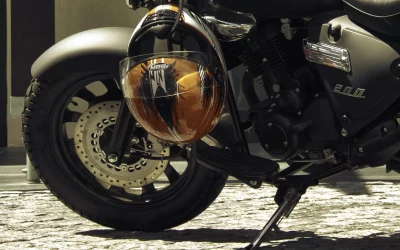Wearing a Helmet Can You Save Your Life?
Motorcycle accidents are horrifying. They often result in serious and permanent injuries, and in some cases, death. According to a Governor’s Highway Safety Association research, a motorcycle death occurs 28 times more often than a passenger car occupant fatality for every mile driven.
For these reasons, it is unsurprising that motorcycle riders must wear a helmet. Helmets not only increase your odds of surviving a motorcycle accident but also reduce your chances of suffering a catastrophic injury.
In this blog article, we’ll go through Colorado’s helmet legislation, explain why helmets are so important for your safety, and help you decide which style of helmet is ideal for you.
The Partial Helmet Law in Colorado
In Colorado, if you are above the age of 21 and have at least $10,000 in medical insurance, you are not obliged to wear a helmet while riding a motorcycle. Even though several states have enacted partial helmet laws, only Michigan and Colorado mandate medical coverage; younger motorcyclists, on the other hand, must wear a helmet regardless of their insurance coverage.
However, just because you have the option of wearing a motorcycle helmet does not imply it is a smart idea to ride without one. Helmets keep motorcycle riders safe, according to years of study.
The Centers for Disease Control and Prevention (CDC) states:
- Using a helmet decreases the chance of fatality in a motorcycle accident by 37%.
- Wearing a helmet decreases the chance of sustaining a head injury in an accident by 69%.
- In a recent year, wearing a helmet was projected to have saved 1,859 lives.
If every motorcyclist wore a helmet, the United States might save more than $1 billion a year in economic losses, not to mention the enormous suffering endured by collision victims and their loved ones.
Despite these startling figures, just 71% of motorcyclists in the United States used a helmet in a recent year. Many (too many, in our opinion) motorcycle riders believe that helmets detract from the joy of riding. Unfortunately, their decision to ride without a helmet is sometimes an expensive and dangerous one.
Motorcycle Helmets: How Effective Are They?
Numerous studies have been conducted over the years to prove that motorcycle helmets save lives and minimize the severity of injuries. Wearing a helmet may avoid 9 percent of all injuries while also being 26 percent effective in preventing serious injuries requiring hospitalization, intensive care, and rehabilitation.
According to the National Safety Transportation Board, head injuries are often the major cause of mortality in motorcycle accidents. However, studies indicate that a biker who is not wearing a helmet and is in an accident is three times more likely to suffer brain injuries than a rider who is wearing a helmet.
However, keep in mind that the sort of helmet you choose is critical if you want to be safe when riding on two wheels. To protect yourself, make sure you’re wearing a DOT-compliant helmet. In a motorcycle collision, they are the only helmets that can consistently avoid harm and death.
Non-compliant helmets (sometimes known as “novelty” helmets) are not designed for highway usage and lack the impact absorption and durability required to protect a rider in an accident.
Manufacturers of novelty helmets will normally include a warning notice stating that they are not intended for use on public roads. Despite these warnings, some motorcyclists continue to ride with novelty helmets on the road, putting themselves in danger (sometimes without realizing it).
The Most Secure Motorcycle Helmet Type
The Snell Foundation, a non-profit memorial foundation founded to advocate for a high-quality standard of helmet safety; the Department of Transportation (DOT); and the Economic Commission for Europe 22.05 are recognized as the leading authorities for setting safety standards for motorcycle helmets suitable for highway use (ECE). Manufacturers of high-quality motorcycle helmets adhere to at least one, and typically all three, of these organizations’ sets of safety requirements.
When selecting a motorcycle helmet, consider the following qualities, which represent the quality and safety of the helmet:
Motorcycle helmets are available in a variety of colors, sizes, and designs. These models range from a full-face helmet to a half helmet to a 3/4 helmet. A full-face helmet is the safest option for optimum protection.
This is often due to the full-face helmet providing the maximum covering around your neck, head, and face. These helmets will not only protect you from flying debris and inclement weather, but they will also shield your chin and jaw, which is essential since the chin receives 50% of the severe impacts in a motorcycle accident.
Motorcycle helmets are equipped with a variety of safety features. However, the most basic safety measures are frequently concerned with impact (how well your helmet protects you from collisions with large objects), retention system strength (does the chin strap keep the helmet in place on impact), positional stability (does the helmet stay in place at critical times), and the extent of protection (does the helmet protect all parts of your head). Choose the helmet with the highest ratings in each of these criteria.
Fit: Your motorcycle helmet should always fit your whole head, which means that the chin strap may be adjusted such that only two fingers fit between your chin and the strap and that there are no gaps in the front, rear, top, or side of your head. If the fit is excruciatingly tight, the helmet is too tiny. If it moves or slides up and down as you turn your head, it is too big.
A helmet that complies with DOT safety regulations will have a certification sticker on it. Never purchase a helmet that lacks a DOT certification sticker. Ideally, the helmet should include stickers or other marks indicating that it satisfies Snell Foundation and ECE requirements.
Remember that numerous non-safety-related helmet features may make a significant difference in comfort and performance. These may include the amount of airflow allowed by the helmet, the size of the eye-opening, sound level consideration, helmet weight, and even the feel of the safety lining. Consider these possibilities, but prioritize safety by giving the qualities listed above high importance when making your ultimate selection.
Other Safety Gear to Consider When Riding a Motorcycle
A helmet is the basic minimum of safety equipment that each motorcycle rider in Colorado should wear. Riders who wish to safeguard their bodies from catastrophic and perhaps deadly injuries should also consider additional types of protective equipment.
Following a helmet, eyewear is very important. A full-face helmet serves as both the rider’s face protection and, in many cases, sunglasses. This is significant since tiny stones, sand, wind, and even bugs may instantly blind a rider, nearly invariably resulting in an accident. Riders who use a 3/4 or 1/2 helmet should always wear goggles or glasses to protect their eyes.
Additionally, motorcyclists need the following for maximum safety:
A heavy-duty, long-sleeved jacket, especially one meant for motorcycle riding and with additional padding to protect the spine;
Gloves;
Shoes; and
Long pants with cushioning and abrasion-resistant fabrics.
Consider using luminous materials and bright colors if you bike at night. They may assist you in being more noticeable to other drivers.
When Should You Replace Your Motorcycle Helmet?
Motorcycle manufacturers and the Snell Memorial Foundation agree that motorcycle helmets should be changed every five years if the rider avoids an accident during that period or promptly after any accident in which the helmet absorbs a blow. However, do not throw away your helmet
after a crash—it might be crucial evidence in your legal lawsuit for damages against the person responsible for your accident.
Why is it five years? Helmet deterioration is a two-word phrase. Helmets simply wear out over time as a consequence of:
Putting on and taking off the helmet, which causes the helmet materials to get packed down and lose part of their impact-absorbing capabilities;
Exposure of the helmet to the elements, including direct sunlight, rain, and road debris; and
natural oils from the hair and skin, cosmetics, cleansers, and even fuel fumes get absorbed into helmet material, causing it to decay.
It is critical for your safety to keep track of how long you have had your helmet and to ensure that it is in excellent functioning order. Another advantage of updating your helmet is that helmet technology is always improving. So, if you update your helmet every five years, there’s a strong chance the new one will provide better protection than your old one.
Injuries Caused by Motorcycles
Motorcycle accidents may cause serious injuries, such as: Brain Injuries Caused by Trauma
A traumatic brain injury, often known as a TBI, is a disturbance in the brain’s normal activities frequently caused by a blow, shock, bump, or penetrating damage to the head. One of the most important tasks of a motorcycle helmet is to absorb and disperse the energy of a hit, channeling it around your head to protect your brain. As previously stated, wearing a helmet lowers your chance of sustaining a traumatic brain injury and minimizes the severity of any TBI you do get, therefore protecting you from sustaining fatal damage.
Injuries to the Spinal Cord
Spinal cord injuries cause the spinal cord to be damaged, resulting in a loss of function, including sensation and motion. Spinal cord injuries are often caused by extreme trauma impacting the road surface following a crash or colliding with another car. Wearing a helmet in conjunction with additional protective gear helps protect motorcyclists against spinal cord injuries, especially those to the top region of the spinal cord, which can result in the most severe disability.
Rash on the highway
Motorcyclists often get severe road rashes after being ejected from the seat in an accident or when they put their bike down and slide while still on it. Friction with the abrasive road surface may rip, wear away, and even burn a rider’s skin, as well as embed road debris in the wound.
Road rash injuries have a high risk of infection. A motorcycle helmet with a complete face shield can protect the motorcyclist’s face from this harmful debris and the consequent lacerations and abrasions common in road rash injuries.
Injury to the Thorax
A thorax injury is one of the most prevalent forms of motorcycle injury. The thorax is defined as the space between the ribs and the sternum. These injuries are often severe because the ribs may pierce other body regions and severely injure internal organs such as the lungs.
While a helmet cannot directly prevent a thorax injury, it can minimize the likelihood of a rider incurring that or any other kind of injury by protecting the rider’s face and eyes, lowering the overall risk of a collision.
The Bottom Line on Motorcycle Helmets
Helmets for motorcycles save lives. Numerous research has shown this. Helmets not only protect motorcycle riders from the severe and deadly head and brain injuries, but they also protect motorcyclists from a variety of other catastrophic and life-altering harm to their faces and bodies, both directly and indirectly.
Of fact, even the greatest motorcycle helmets cannot prevent every collision. Even if you ride your motorcycle with caution and wear all of the proper protective gear, you might still be involved in a crash that results in serious injuries.
If you were injured in a motorcycle accident caused by someone else’s reckless choices or acts, you might be entitled to considerable compensation. To learn about your rights and legal alternatives, contact an expert motorcycle accident attorney now for a free consultation.







